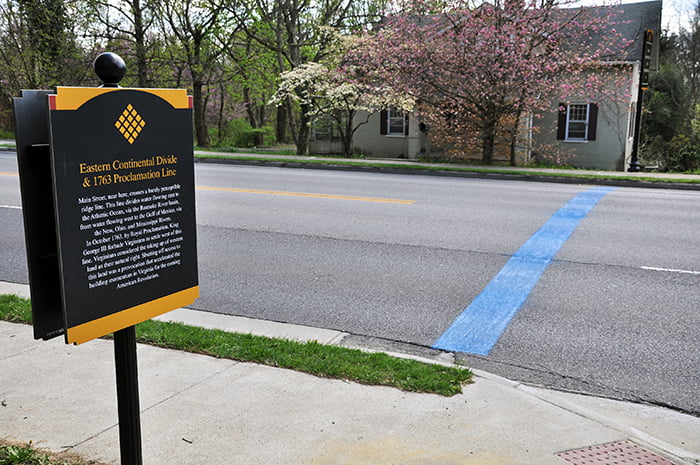The Town of Blacksburg and the Blacksburg Museum & Cultural Foundation, recognizing the significance of the Eastern Continental Divide, have emphasized with a painted blue line where it crosses South Main Street near Sunset Boulevard.

Signs are also posted nearby to identify the divide and explain its significance to local and national histories.
The sign reads:
Main Street, near here, crosses a barely perceptible ridge line. This line divides water flowing east to the Atlantic Ocean, via the Roanoke River basin, from water flowing west to the Gulf of Mexico, via the New, Ohio, and Mississippi Rivers. In October 1763, by Royal Proclamation, King George III forbade Virginians to settle west of this line. Virginians considered the taking up of western land as their natural right. Shutting off access to this land was a provocation that accelerated the building momentum in Virginia for the coming American Revolution.
The Eastern Continental Divide is the geographical feature that separates the Atlantic Seaboard and Gulf of Mexico watersheds.
In the middle part of the Atlantic Seaboard states, it runs roughly along the ridges of the Alleghany Plateau and the Appalachian Mountains from Pennsylvania to Georgia where it flattens until it reaches the tip of Florida.
The divide separates waters flowing to the Atlantic Ocean from those flowing to the Gulf of Mexico. It is an important feature of Blacksburg for geological and historical reasons.
Geologically, waters from the north part of Blacksburg flow to the Gulf of Mexico. Stroubles Creek, Tom’s Creek, the springs on Clay Street and Draper Road and the waters from the Virginia Tech Duck Pond all flow to the Gulf of Mexico. Many of these streams and springs have been covered but some are still visible.
The spring on Clay Street near Wharton Street, called Spout Spring, was once the main source of water for Blacksburg. It can be seen in several places, including beside the Main Street Inn on South Main Street.
Waters that flow from south Blacksburg such as from the pond in front of First and Main form one branch of the Roanoke River and flow through the Ellet Valley to the Atlantic Ocean through Albemarle Sound.
There are many places in Blacksburg where one can actually stand on the Eastern Continental Divide and pour water that flows east and west. It is possible to see the general outline of the Eastern Continental Divide from the town golf course.
The Eastern Continental Divide is also an important historic landmark in Blacksburg.
The Draper’s Meadow Massacre in 1755 is considered by some as one of the first incidents that resulted in the French and Indian War also called the Seven Year’s War in Europe.
The origin of the Draper’s Meadow settlement occupied much of the watershed of Stroubles and Tom’s Creeks but was abandoned after some settlers were killed or taken prisoner in the massacre. Mary Draper Ingles was the most famous of these prisoners.
Following the Treaty of Paris in 1763 which settled the French and Indian War, King George III proclaimed that all of the lands to the east of the divide were for the English to settle whereas the lands to the west were reserved for Native Americans.
Thus, the divide was also called the Proclamation Line and was quickly ignored by future settlers who considered it their natural right to move west.
For 20 or so years, Blacksburg was a gateway to the west for settlers who came up the Alleghany Plateau on what is now Harding Avenue and Roanoke Street.
It is noteworthy that William Preston built his mansion Smithfield to the west of the Proclamation Line in open defiance of King George III.
Among other provocations, the proclamation restrictions contributed to the growing demands to be free from English domination that began to emerge just three years later in the 1766 Leedstown Resolves and, then, ten years later in the Declaration of Independence.
Virginians were leaders in separating from England and the historic legacy of Blacksburg is to have been important in the movement seeking independence.
To learn more about the history of Blacksburg visit blacksburgmuseum.org or stop by one of the museums: Alexander Black House & Cultural Center at 204 Draper Rd. or St Luke & Odd Fellows Hall at 203 Gilbert St. For information or hours of operation, call 540-558-0746.



